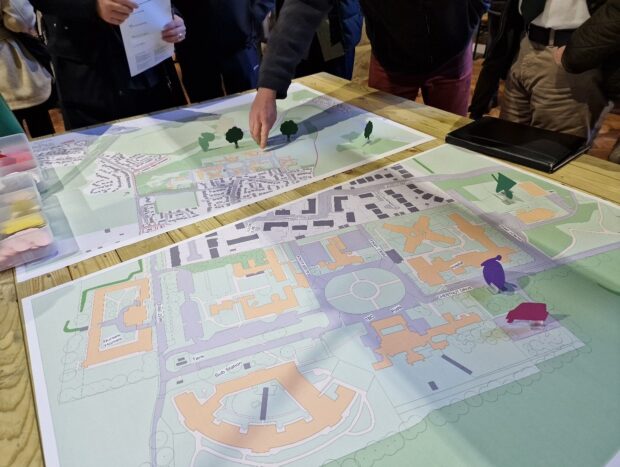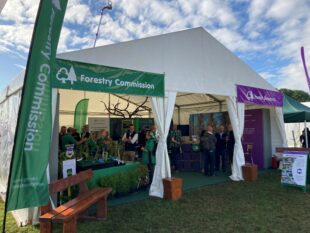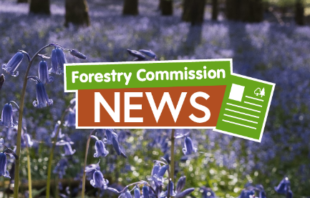 Robin Gray, Landscape and Woodland Design Advisor at the Forestry Commission, explains why consultation is needed, how it benefits you and outlines key considerations for an effective consultation.
Robin Gray, Landscape and Woodland Design Advisor at the Forestry Commission, explains why consultation is needed, how it benefits you and outlines key considerations for an effective consultation.
I often support consultation events using the Forestry Commission’s Landscape Character Appraisal to engage with a wide range of stakeholders.
This blog covers the wider community beyond the range of statutory and non-statutory consultees who will need to be engaged in a scheme, which could include Natural England, the Gardens Trust, Protected Landscapes or the Environment Agency. Here I'll share why consultation is needed, how it benefits you and the key considerations for an effective consultation with local communities and stakeholders.
Why is consultation needed?
Firstly, it’s important to know that public involvement is a key aspect of the UK Forestry Standard and can come in many forms. For example, Forestry England could be working with a local community on a new woodland creation scheme, or an agent could be leading a consultation on a woodland management plan. Consultation needs to be proportionate to the size and complexity of individual schemes. It gives everyone an opportunity to be heard.

How does consultation benefit you and your stakeholders?
Consultation brings local people and stakeholders together to discuss and feedback on proposals. It helps to gather diverse viewpoints and improve decision-making and trust within the community. It can also help you get the necessary buy-in needed for you to go ahead, improve your overall proposal and mitigate any future challenges you could face later down the line.
When should you consult?
Not every project will need intensive consultation, but a well-run consultation can save time and reduce misunderstandings, especially on complex or large-scale proposals. Moreover, early engagement can lead to better public awareness and an improved scheme overall. The type of consultation you take may well depend upon timescales. Equally, the timing of consultation is critical. For example, in rural areas try to avoid an event that might be in the middle of lambing season to avoid alienating busy farmers.
What do you want to achieve from consultation?
Be open with your audience about what they can realistically influence through the consultation process. Is this a one-off event to comment on a scheme or are you at the start of a longer-term dialogue where you are seeking input? You should avoid a superficial consultation at the final stages of design, as this is not good practice. Participants will make their minds up quickly if this is just a ‘tick-box’ exercise, so be clear that their opinion matters.
Know your audience
It’s likely that participants are more familiar with the site than you are. For example, a local dog walker will have a connection to your site and see it daily through the seasons. They may have strong personal connections to your site that they cherish. It’s important to harness this knowledge to inform your design. For example, local bird watchers may know the exact bird species present on your site, and your design can take account of this by incorporating suitable edge or open space for those species.
Think about those outside the room. There will always be landscapes that have an audience far beyond the local community. Indeed, we have had individual responses to applications on the public register from overseas on cherished views within UK National Parks.
Is your audience representative of the local community?
Consider ‘mapping’ your wider stakeholders to ensure you are fully representative of your local community. Elected officials are there to represent their community and can be valuable supporters of a scheme. Parish councils and local authorities can also be a gateway to wider participation and can consider wider impacts. For example, I was at a meeting where there were many questions asked about access to a site which remained unanswered, because the local authority officer responsible for access had not been invited to the consultation event.
Who should be involved in consultation?
Consider who is in the room and who is not, to avoid a vocal minority dominating your meeting when not every audience is represented. In my experience, it’s often the views of families with young children that are under-represented due to childcare constraints. Therefore, it can be helpful to host smaller meetings, site walks or drop-in style events at different times of the day to encourage better representation.
Be prepared on social media
Have you considered how social media could be used or will be used to communicate information about your proposal? You should be prepared to deal with any opposition to your scheme in a positive way. Social media has changed the nature of how we engage, with debates online that might mirror or cut across more formal consultations being played out almost immediately. Being prepared and able to react to social media is a challenge but critical to the perception of your organisation and your project.
Attitudes to woodland creation
There can be differing attitudes to woodland creation. Research commissioned by the Forestry Commission in 2022 from Research Box, sought views from the public about their appetite for woodland creation in a number of landscapes.
There was a common view that the countryside ‘manages itself’ and questions as to whether tree tubes are necessary for young trees. Attitudes like this should be addressed, and reasons for ongoing woodland management and adequate protection for trees during establishment need to be clearly explained.
Positively, we also found good evidence that the public align with many of the woodland design principles within the UK Forestry Standard, especially around creating woodland that reflects the current landscape in its design.

Have you adequately resourced your consultation?
There will be many schemes which require a light touch approach, but you shouldn’t ever underestimate the concerns of neighbours. For larger schemes, often a more comprehensive consultation is required.
Having booked your village hall and key speakers, it’s time to think about how you are going to chair your meeting and manage engagement. Decide if this needs to be an evening or daytime meeting and be aware this will draw in different audiences.
It’s best to invite feedback and discussion throughout the event rather than just at the end. Facilitating an exercise that can collect views or even actively design a scheme could be appropriate. As Landscape and Woodland Design Advisors, we have delivered workshops to design woodland in a collaborative way – this co-design approach can be a powerful tool as everyone involved feels invested in the final scheme.
How to convey your story
Begin with what makes your site and landscape special – there should be much to agree on with your audience. The story is rarely just about the trees. The landscape context plan within the Forestry Commission’s appraisal will help you to record what is important on site. Providing simple visualisations can be a clear and useful way to communicate your proposal.
Share your research
Share the knowledge you have gathered from extensive research on your site’s heritage, ecology and landscape. Seek input from those attending to gain a mutual understanding of your proposal and try to use technical terms sparingly.
How to communicate
A combination of communication methods to engage with your community may be best. These can include letter drops, social media activity, newsletters or local exhibitions.
Think about how you will respond to your audience, and if this needs to be regularly or a one-off feedback meeting. Keep a record of your meetings and share this with your audience to keep everyone informed. In the long term this can pay dividends, as a good relationship with your community can help to address issues on site, both during and after a contract, or can help to identify unintended consequences of a project, such as reducing surface water from your site to reduce flooding downstream.
Effective consultation is a good way to share information and engage with communities about our projects. Early consultation works best, so that we can address any misinformation and account for stakeholder views when finalising plans.
- Liz Houseman, Woodland Creation and Management Plan Co-ordinator, Tilhill Forestry
Manage expectations
The necessary elements of woodland creation, which includes protection such as tree tubes and fencing, may look different to how a community first imagined the woodland to look. Maintenance is often raised as an issue.
Maintenance can mean different things to different people. You may well be thinking about tree establishment whilst a local resident might be thinking about fly-tipping, litter and dog fouling. It’s important to consider your response to these issues.
For example, I have seen schemes badged as a ‘Country Park’, a concept that creates an impression of facilities, staffing and intensive management, but that might not be the reality. It’s important to be clear about your scheme to avoid ambiguity.
Present different visuals of plans and maps
Residents can have a very different awareness of their locality. A Geographic Information System (GIS) plan (that looks much like an Ordnance Survey map) may not capture how residents will perceive your site. Be prepared with different approaches to help present your scheme.
For example, a good visualisation can address misapprehension about views into and out of your site. The Forestry Commission’s Landscape Character Appraisal suggests ways of illustrating schemes.

Dealing with conflict
Consider how you are going to resolve conflict. Is there an independent chair or facilitator that is trusted by all parties that can attend? Think about your stakeholders and their appropriate level of involvement. Views from neighbours may best be considered on site where visual impact can be discussed. Local groups may be better met on their own so they can freely express their views.
Finally, treat everyone with respect. Understanding the position of participants is essential even if you don’t agree with their views, and this can particularly be the case on social media.
Building trust through the process
Trust can be built over time through constructive dialogue. It requires active listening on the part of the applicant and allowing participants the opportunity to be heard. Long-term projects can develop an approach led by local stakeholders with genuine co-design, which can have positive outcomes.
The Neroche Landscape Partnership Project led by the Forestry Commission in the Blackdown Hills National Landscape is an excellent example of working in partnership. The project co-opted local stakeholders into the decision-making process, which eventually led to the development of a Trust to support continued public engagement to steer management on Forestry England land holdings. This was a long-term approach that took many years to deliver and remained robust through later challenges.

Landscape and Woodland Design Advisors at the Forestry Commission are on hand to share best practice and guidance to help you deliver an effective consultation.
Email landscape@forestrycommission.gov.uk for advice on your consultation plans.


